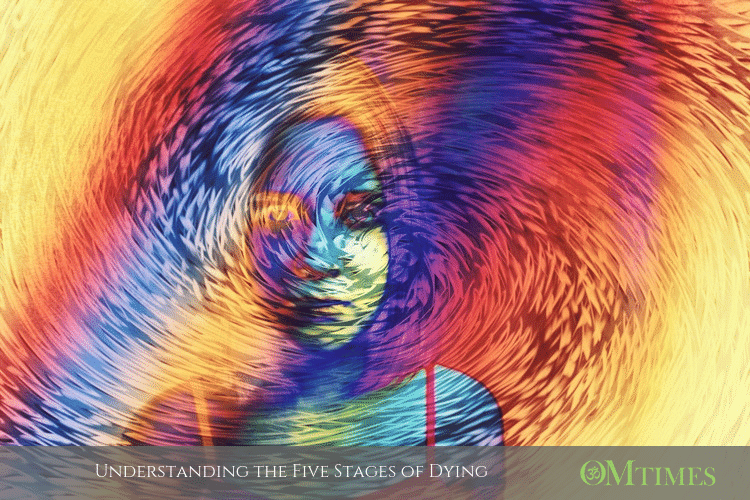Understanding the Five Stages of Dying

We all know that death will ultimately claim our loved ones and us. In modern times we’ve removed ourselves from the process, so neither we nor our dying beloveds understand how our bodies and souls separate in death. In this article, we will explore the five stages of dying by relating them to ancient mystical traditions that connected our lives with the planets through the five elements of earth, water, fire, air, and spirit.
Living Intuitively: Understanding the Five Stages of Dying
by Robyn M Fritz, MA MBA CHt
While we all know that death is inevitable, and many of us have lost beloveds, most of us are not familiar with the actual process of dying. A common theme in my mediumship practice is how confusion about the dying process compounds grief—for the living and the dead.
Mystical Tradition and the Dying Process
It is understandable since death has been hidden away from us for decades. Fortunately, we are now encouraged to be present with our beloveds as they die, as our ancestors were with theirs: they knew that it helps the dying on their journey to the afterlife and helps us live on without them.
Our ancestors also understood how we die, recognizing death as a sacred process tied to mystical traditions that connect our lives with the planets through the five elements of earth, water, fire, air, and spirit. These elements are incorporated into our bodies when we are born and separate of us in stages when we die. Death, then, is the separation of the soul from the body, or the dissolution of the body as the soul leaves. Yes, it can be scary to see this happening to a beloved, but it is the process, both stunningly beautiful and heartbreaking to witness.
I learned about the five stages of dying from research, from Betsy Bergstrom, a Buddhist shamanic practitioner in Seattle, and from being present with my dying father. As we review the five stages here, remember that death isn’t a lockstep process: we don’t always experience real boundaries between stages, especially in sudden death. However, if you’re with a dying beloved, understanding the stages will help them, you, and other survivors.
Stage 1: Earth
The earth stage is connected to our skeleton, our physical body. In the early stages of dying, the body weakens. Your beloved may be shaky, unable to fully stand up, or may slide down in bed, even when supported. Pay attention.
Stage 2: Water
When your beloved starts having trouble communicating, the water stage has arrived. As water dissolves the body dries out, and even acts thirsty, resulting in chapped lips, papery skin, dull hair, and flat eyes with an opaque or filmy appearance.
Stage 3: Fire
The fire stage is connected to blood—the circulatory system, including the heart. Here the hands and feet become cold as the body tries to keep its organs warm by pulling heat back to the torso. The dying begins to lose consciousness, either becoming unconscious or losing receptivity.
It’s critical to be prepared for death at this stage because this is when “existential angst” can set in: as the emotional body begins to die, worries and fears arise, and cultural conditioning, or cosmology, can be tested and broken. Doubt tests faith, so whatever our beliefs in spirit guides, guardian angels, deities, or religious traditions maybe when we’re fully functioning, this stage challenges belief and certainty. If this happens, the likelihood of becoming stuck after death, and not making it to the afterlife, dramatically increases.
While we can and should offer body, mind, and spiritual support throughout the dying process, in the fire stage we should get proactive and ask our spiritual team and our dying beloveds to step in and help (yes, we can all do this). Dying is confusing: the dying may refuse their team’s support because they no longer recognize them (if they ever did), so it’s critical to get all-hands-on-deck because this is when active dying begins.
Stage 4: Air
As the element air recedes, the dying person cannot breathe normally. The time between breaths increases, breathing is intermittent, or it is shallow and fast paced for a few beats before it slows. Very little air is going in at this point, and it leaves in gasps or gentle waves. It ends in a final exhalation: death.
Stage 5: Spirit
The body is dead, but the soul may temporarily remain, perhaps for hours or even days, even though in the spirit stage there is a complete dissolution of the body and soul. However, our work as survivors isn’t over, because the soul may need guidance. In my mediumship practice many of the dead tell me they were still able to see and hear the living, so they didn’t realize they had died, or they were conflicted, both relieved to be free of the dying process, but grieving that they died.
Whether your beloveds have just died, or you’re reading this year later, you can still help guide them to their afterlives by telling them point blank that they are dead: explain what happened, tell them you love them, urge them to accept their spiritual team, which is surrounding them to help, and encourage them to move on.
You can do this while performing whatever death ritual works for you, especially if it’s one you worked out with your beloveds ahead of time. The ritual will help both sides by offering closure to the dying process and hope for an eventual reunion. It matters to them and you.
Click HERE to Connect with your Daily Horoscope!
You will also enjoy Why Some Suffer Before Passing Over
About the Author
Robyn M Fritz MA MBA CHt hosts the OM Times radio show, “The Practical Intuitive: Mind Body Spirit for the Real World.” An intuitive and spiritual consultant and certified past life regression specialist, she is an award-winning author whose next book is “The Afterlife Is a Party: What People and Animals Teach Us About Love, Reincarnation, and the Other Side.” Find her at RobynFritz.com.
OMTimes Magazine is one of the leading on-line content providers of positivity, wellness and personal empowerment. OMTimes Magazine - Co-Creating a More Conscious Reality




